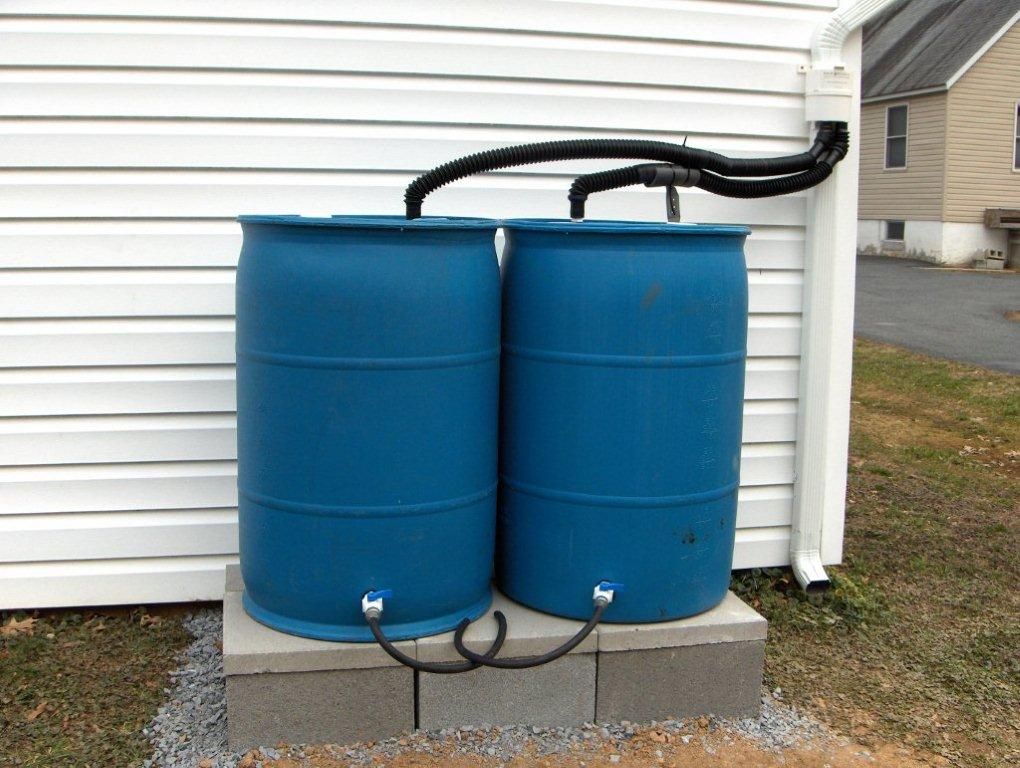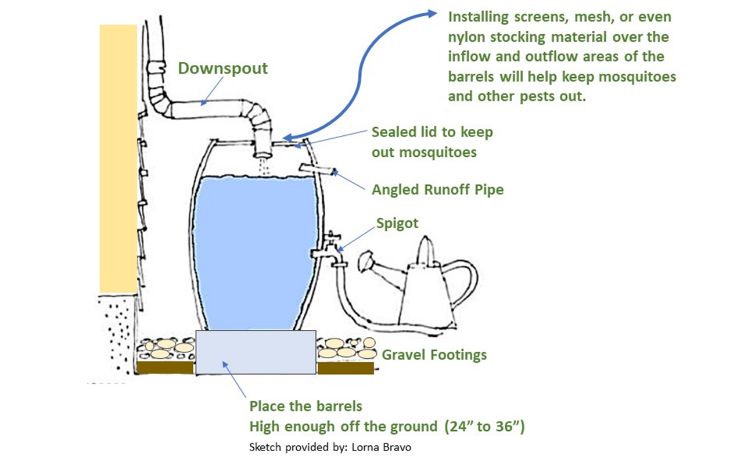Rain Barrel Water Quality in South Florida
Rain barrels are a great way to conserve water, save money, and contribute to a sustainable landscape. By collecting rainwater, we also reduce the amount of water flowing off our properties into the surrounding environment. Because the average rainfall in Florida, based on weather data collected from 1991 to 2020 from the US National Centers for Environmental Information, ranges from 48 to 73 inches in a year, rain barrels are an excellent resource of water to use in our gardens and landscape.

Credit: Kimberly Moore, UF/IFAS
Installing rain barrels is a relatively easy and affordable way to make your home more sustainable. (For more information, see EDIS publications EP424, EP374, and AE029.) It's a small step you can take towards reducing your environmental footprint and promoting a healthier planet. With so many benefits, installing a rain barrel system in your home is worth consideration. This publication is therefore intended for homeowners interested in rain barrel systems.

Credit: Lorna Bravo, UF/IFAS
Rainwater is naturally soft and free of chemicals, like chlorine and fluoride, that may be present in municipal water supplies, making it a great choice for watering your plants and gardens. However, it can be challenging to get people to adopt rain barrels because of concerns about water quality, especially from contact with different roof types (Shuster et al., 2013; Hamilton et al., 2018). Some research has shown that runoff from the roof might have some levels of zinc (Zn), lead (Pb), and polycyclic aromatic hydrocarbons (PAHs) (Bannerman et al. 1993; DeBusk et al. 2011; Van Metre and Mahler 2003; Gikas and Tsikriktsis 2012). Another common concern is water contamination by pathogens from animal fecal matter on the roofs.
The question remains: is water from rain barrels safe to use? Our purpose for this article is to address concerns about water quality from rain barrels used in south Florida landscapes, so homeowners can better utilize this water in their gardens and landscape. To get a better handle on rain barrel water quality, we analyzed the pH, soluble salt levels (electrical conductivity, [EC]), and nutrient levels in rainwater collected from tile, shingle, and metal roofs in south Florida. To test for E. coli and coliform in the water, we purchased the AquaVial Well Water testing kit (for drinking water, pool, pond, lake, and well water) from Amazon. We chose to use a kit like this, which any homeowner could purchase and use.
We sampled the water from 60 rain barrels. We had 25 samples from tile roofs, 20 from shingle roofs, and 15 from metal roofs. Ideally, we would have preferred more samples of tile and metal roof types. However, when we analyzed the data as a group of 60 samples, there was no difference based on roof type.
According to our water analysis, no E. coli was present in any samples (Table 1). We suspect that the high solar radiation and temperatures in south Florida killed potential pathogens. This is an important factor to consider in south Florida when testing pathogens' presence in rain barrels connected to roof gutters. From 1998 to 2016, the average levels of solar radiation hitting roofs in south Florida was 5.00 to 5.25 kilo Watt hours/m2/day. (See the data from the National Solar Radiation Database at this link: https://www.nrel.gov/gis/assets/images/solar-annual-ghi-2018-usa-scale-01.jpg.) These solar levels give us roof temperatures ranging from 124⁰F to 150⁰F. Temperatures greater than 149⁰F will kill bacteria in water, and most plant pathogenic bacteria and fungi will die in soils at temperatures ranging from 130⁰F to 145⁰F.
Furthermore, nutrient levels were minimal, and we detected no harmful nutrient elements. There was also no difference in nutrient levels based on roof type (shingle, tile, or metal) (Table 1). When we compared our rain barrel water quality data to water analysis of the ponds and city water on the UF/IFAS Fort Lauderdale Research and Education Center property, our rain barrel samples were better quality for growing plants. We sampled five ponds on the Fort Lauderdale REC property as well as five hoses attached to city water lines (Davie, FL). (The results are that pond pH = 7.1; pond EC = 0.51dS/m; hose pH = 7.2; hose EC = 0.55 dS/m; rain barrel pH = 6.6; and rain barrel EC = 0.08 dS/m.) Although the pond water and hose water measured slightly higher in salt levels, we can still consider both acceptable for growing plants.
Based on our analysis, the rainwater from rain barrels in southern FL is an excellent water source for non-potable uses. Our results support the recommendation from Rain Barrels – A Homeowners Guide (2022) by the Southwest Florida Water Management district, that there are no concerns with non-potable uses or occasional contact by the homeowners with water from rain barrels.
References
Bannerman, R., D. W. Owens, R. B. Dodds, and N. J. Hornewer. 1993. “Sources of Pollutants in Wisconsin Stormwater.” Water Science & Technology. 28(3-5): 241-259. https://doi.org/10.2166/wst.1993.0426
Bucklin, R. 2017. Cisterns to Collect Non-potable Water for Domestic Use. AE64. Gainesville: University of Florida Institute of Food and Agricultural Sciences. https://edis.ifas.ufl.edu/publication/ae029
DeBusk, K. W., W. F. Hunt, D. L. Osmond, and G. W. Cope. 2011. Water Quality of Rooftop Runoff: Implications for Residential Rainwater Harvesting Systems. (AGW-588-11). Raleigh, NC: NC State Extension. content.ces.ncsu.edu/water-quality-of-rooftop-runoff
Gikas, G. D., and V. A. Tsikriktsis. 2012. “Assessment of Water Quality of First Flush Roof Runoff and Harvested Rainwater.” Journal of Hydrology. 466-467: 115-126. https://doi.org/10.1016/j.jhydrol.2012.08.020
Hansen, G. 2019. Landscape Elements for a Florida-Friendly Yard. ENH 1163. Gainesville: University of Florida Institute of Food and Agricultural Sciences. https://edis.ifas.ufl.edu/publication/EP424
Hansen, G. 2022. Design Strategies for a Sustainable Home Landscape. ENH 1110. Gainesville: University of Florida Institute of Food and Agricultural Sciences. https://edis.ifas.ufl.edu/publication/EP374
Hamilton, K.A., K. Parrish, W. Ahmed, and C. N. Haas. 2018. “Assessment of Water Quality in Roof-Harvest Rainwater Barrels in Greater Philadelphia.” Water. 10(2): 92. https://doi.org/10.3390/w10020092
Shuster, W.D., D. Lye, A. De La Cruz, L. K. Rhea, K. O’Connell, and A. Kelly. 2013. “Assessment of Residential Rain Barrel Water Quality and Use in Cincinnati, Ohio.” Journal of the American Water Resources Association. 49(4): 753-765. https://doi.org/10.1111/jawr.12036
Van Metre, P. C., and B. J. Mahler. 2003. “The Contribution of Particles Washed from Rooftops to Contaminant Loading to Urban Streams.” Chemosphere. 52(10): 1727-1741. https://doi.org/10.1016/S0045-6535(03)00454-5
Watson, G., C. Claus, L. Barber, G. Beck, J. W. Marvin, and E. Momol. 2022. Rain Barrels – A Homeowner’s Guide. Southwest Florida Water Management. https://www.swfwmd.state.fl.us/sites/default/files/store_products/RainBarrelGuide10.11.22.pdf
Whipker, B., Dole, J., Cavins, T. and Gibson, J. 2003. “Water Quality.” In Vol. 2 of Ball RedBook, 17th edition, edited by D. Hamrick. Batavia, IL: Ball Publishing.
Table 1. Water quality analysis from rain barrel samples collected in 2022 from 60 Broward County residents with rain barrels. Samples were sorted by roof type - shingle, tile, or metal. The standard levels are for plant growth and not for drinking water quality.



